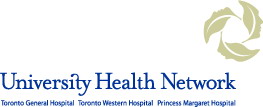基本信息
University Health Network(簡稱UHN,中譯名:大學健康網路)是一家有著200多年經營歷史的加拿大公司,下轄瑪格麗特公主醫院、多倫多中心醫院和多倫多西部醫院等三所大型醫院。UHN是加拿大的醫療保健體系的重要里程碑,是加拿大多倫多大學的教學醫院。UHN的願望是實現對全球的影響,它的使命是提供模範的醫療護理,醫療研究和教育。它的宗旨是創建一個充滿愛心、有創意和有責任感的教學醫院,給病人給社會,給世界帶來健康。它的價值觀包括:關懷、卓越、團隊、創新以及尊重。2008年10月,UHN榮獲MediacorpCanada Inc機構頒發的“加拿大最佳僱主100強”稱號,同年11月份,UHN又當選由《多倫多星報》授予的“多倫多卓越僱主”。
三個側臉形輪廓的圖形代表三家醫院,也代表了三個承諾,病人護理,醫療研究和醫療教學。它們在一起,形同樹葉一樣連線,形成一個連貫的圓圈,意味著合作與完成。圖形的金色象徵著素質,要用成功的態度和卓越的醫學不斷進行探索,來迎接不斷增加的挑戰和現實。而文字的藍色是醫院的傳統顏色。
多倫多中心醫院
簡稱TGH,UHN下三家醫院之一。它在心臟監護、器官移植和複雜病人治療方法上是領先的。 它包含UHN的三個主要中心(彼得芒克心臟中心、移植中心和急救護理中心),它以高素質的志願者隊伍和專門致力於UHN的影響,來實現全球眼光。多倫多西區醫院
簡稱TWH,UHN下三家醫院之一。它位於多倫多市中心。TWH已經提供了超過100年的社區照顧及專業服務。它在神經科學、肌肉骨骼健康與關節炎和醫療社區衛生項目提供世界級一流服務。它也有一些門診診所。它的核心是以病人為中心的護理。它的神經科學水平世界領先,並且不斷沖在研究的前沿,提供最先進的技術治療。 這家醫院還擁有強大的社會關注的焦點,提供信息的創新方案,兒童,老年人,糖尿病患者和許多多元文化群體。瑪格麗特公主醫院
簡稱PMH,UHN下三家醫院之一。它的研究機構和安大略癌症研究所已實現了在同癌症作鬥爭的全球領袖的國際聲譽。 它的有許多在腫瘤臨床研究達到世界領先水平專家,包括:腫瘤外科、骨髓移植、化療、放射腫瘤學、心理腫瘤學、血液學、放射治療和醫學成像。關於研究
快速的科學發展,使醫學研究到了一個令人興奮的地步。UHN的研究人員也正處於這個興奮中。在最近一年裡,UHN的研究人員在對抗癌症,瘧疾,飲食失調,心臟疾病和帕金森氏症等取得重要進展。UHN的研究機構和中心是列入加拿大最優秀行列的:Ontario CancerInstitute
Director: Dr. Benjamin Neel
Advanced MedicalDiscovery Institute
Director: Dr. Tak Mak
The Campbell FamilyCancer Research Institute
Director: Dr. Benjamin Neel
TheCampbell Family Institute for Breast Cancer Research
Director: Dr. Tak Mak
TorontoGeneral Research Institute
Director: Dr. Richard Weisel
TorontoWestern Research Institute
Director: Dr. Peter St George-Hyslop
為了在生物醫學和保健研究領域取得全球影響,在UHN里有大約2700名科學家,技術人員,學生正在共同努力,解決基本問題及其套用研究。 一份“未來計畫”指出UHN的戰略目標將是優先在以下四個領域進行研究:
* 基因,蛋白質和人類
* 醫療技術創新
* 健康信息
* 再生醫學
UHN主要統計數字
* 擁有536名研究人員
* 擁有843名學員
* 擁有1330名技術人員
* 出版1665份出版物
關於教育
UHN是加拿大最大的教學醫院之一。我們是訓練本科聲、研究生、住院醫生、內科醫生、護士和其他衛生保健專業人員的領導者。教導學生健康護理專業不僅是UHN的目標,還要不斷提供可持續教育,使UHN能為患者的健康提供相關的和有用的信息。所以,UHN也是一個授權的教育機構。它和多倫多大學醫學院建立了夥伴關係,領導著教育與研究工作。UHN是加拿大多倫多大學值得驕傲的分支機構,每年,UHN都對1000多個醫學院學生、研究員和護士進行教育,從職業治療、物理治療和語音語言病理學等進行培訓。UHN和多倫多大學的合作提供了一個用於前沿研究的堅實基礎。關於UHNShanghai
UHNShanghai,全稱UHN Shanghai Research & Development Co., Ltd.是UHN下屬的全資中國子公司。公司的中文註冊名是醫恩醫療系統研發(上海)有限公司,簡稱醫恩醫療。公司以加拿大和中國為基地,以先進的化學技術、醫學技術為專業主體,集研發、生產、經營於一體,是一支具有專業背景、朝氣蓬勃、有高度創造天賦的團隊。醫恩醫療具有高等級的專業運作資格和良好的商業信譽,被眾多化學公司和科研機構認定為“指定供應商”和“國際化學項目合作協調中心”。UHN世界首創
UHN取得的一些成就。1922: Clinical use of insulin for diabetes – Dr. Frederick Banting and Dr. Charles Best
1935: Clinical use of Heparin as a blood thinner – Dr. Gordon Murray
1946: Design and use of North America’s first artificial kidney – Dr. Gordan Murray
1950: Use of first regulated cardiac pacemaker – Dr. Bill Bigelow
1950s: Use of radiation to cure Hodgkin’s disease – Dr. Vera Peters
1950s: Introduction of lumpectomy for breast cancer – Dr. Vera Peters
1950: Use of total body cooling as a method of making heart surgery safer – Dr. Bill Bigelow
1951: Use of cobalt radiotherapy units for cancer – Dr. Harold Johns
1955: Human heart valve transplant – Dr. Gordan Murray
1960s: Coronary Care Unit – Dr. Robert MacMillan and Dr. Ken Brown
1961: Discovery of blood forming stem cells enabling bone marrow transplants – Dr. Ernest McCulloch and Dr James Till
1965: Developed prototype aneurysm clip – Dr. William Lougheed
1973: Use of pulmonary testing called flow volume loop to diagnose small airway disease (e.g., asthma and COPD) – Dr. Noe Zamel
1975: Development of software used worldwide for 20 years to control radiation therapy – Dr. Jack Cunningham
1976: Identification of P-glycoprotein as a major cause of cancer drug resistance – Dr. Victor Ling
1977: Developed a technique for Peritoneal Dialysis that made it possible on a large scale – Dr. Dimitri Oreopoulos
1978: Discovery of reversibility of brain damage from alcohol with abstinence – Dr. Peter Carlen
1983: Successful single lung transplant – Dr. Joel Cooper
1984: First cloning of the T-cell receptor genes, significant in the field of immunology - Dr. Tak Mak
1985: Reconstruction of the mitral annulus (the supporting structure for cardiac valves) – Dr. Tirone David
1986: Use of a patch technique to repair ruptures of the heart wall following a heart attack – Dr. Tirone David
1986: Successful double lung transplant – Dr. Joel Cooper
1987: Development of a new pig valve to replace the diseased aortic valve – Dr. Tirone David & Dr. Chris Feindel
1988: Operation to spare the aortic valve in patients with aortic aneurysm – Dr. Tirone David and Dr. Chris Feindel
1988: Mapping and surgical correction of cardiac rhythm disorders – Dr. Lynda Mickleborough and Dr. Eugene Downar
1989: Treatment of sleep apnea in patients with heart failure by mechanical assist device (CPAP) reduces morbidity and mortality – Dr. Doug Bradley and Dr. John Floras
1991: Reconstruction of the inflow and outflow tracts of the heart using two conduits – Dr. Tirone David
1992: Developed a novel experimental technique that employs chemical substances to prevent or treat brain damage from stroke or trauma by regulating cell calcium levels – Dr. Chris Wallace
1994: Showing genetic predisposition to developing Reflex Sympathetic Dystrophy – Dr. Angela Mailis
1996: Transplantation of heart cells into damaged and scarred heart muscel to improve heart function – Dr. Ren-Ke Li and Dr. Richard Weisel
1996: Description of a substance that causes intestines to regrow (GLP-2) – Dr. Dan Drucker
1996: Awake craniotomy with same day discharge for brain tumour removal using image guided approach - Dr. Mark Bernstein
1996: Chemotherapy treatment for hormone-resistant prostate cancer – Dr. Ian Tannock and Dr. Malcom Moore
1990s: Identification of genes responsible for hereditary blindness, Alzheimer’s, Lou Gehrig’s and Huntington’s disease – Dr. Peter St. George Hyslop
1999: Identifying the individual brain cells that control pain – Dr. Karen Davis and Dr. Andre Lozano
2000: Identification of novel T regulatory cells to induce tolerance in transplant patients – Dr. Li Zhang
2000: Identification of the novel immune molecule CD 200 to modify host immune response in transplantation – Dr. Reg Gorczynski
2001: Determining the utility of 2 hour post dose cyclosporine levels to improve clinical outcomes in transplantation – Dr. Gary Levy and Dr. Ed Cole
2001: Development of new pig valve and aorta to replace the diseased aortic root – Dr. Tirone David
2001: Discovery that a protein called Interleukin 13 fuels the growth of Hodgkin’s lymphoma – Dr. Tak Mak
2001: Development of the “Marshall Score” for classifying Multiple Organ Dysfunction Syndrome – Dr. John Marshall
2002: Discovery that fragile X syndrome (most common inherited cause of mental retardation) is related to glutamate in the brain – Dr. Peter Carlen
2002: Description of the role of IRAK-4, an immune molecule, critical for first-line defense against infections – Dr. Wen-Chen Yeh, Dr. Tak Mak and Dr. Pam Ohashi
2002: Proof of efficacy of new treatment for HIV infection – Dr. Sharon Walmsley
2002: Demonstrating that dense breast tissue, a major risk factor in breast cancer, is mainly determined by genetic factors - Dr. Norman Boyd.
2002: Identification of protein that triggers autoimmune response in Sj?gren’s syndrome, as well as a vaccine to treat the condition – Dr. Arthur Bookman
2002: Deduction of the structure of a molecular complex in the brain involved in many functions including memory and learning – Dr. Mitsu Ikura
2002: Identifying gene clusters using microarray technology that are involved in lung cancer – Drs. Denis Wigle, Igor Jurisica, Jim Woodgett, Shaf Keshavjee, Gail Darling, Frances Shepherd and Ming Tsao
2003: Developing method for detecting gene mutations that enhance care for families with retinoblastoma – Dr. Brenda Gallie
